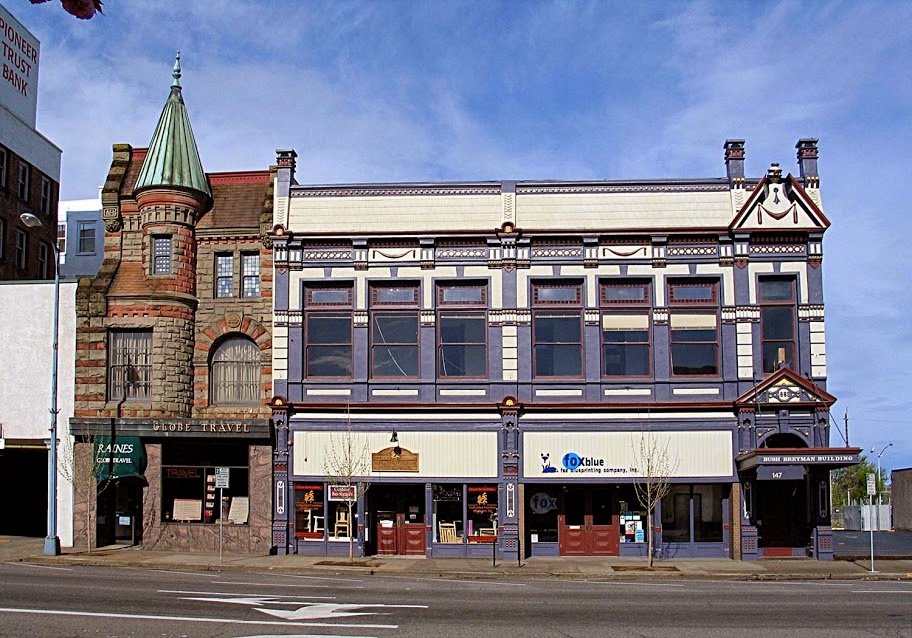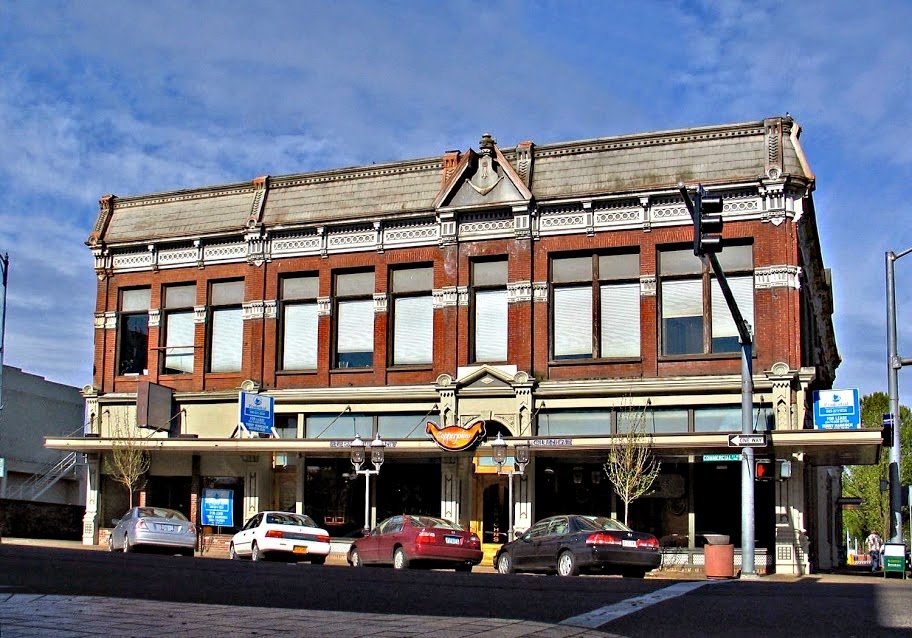- The Dakotas, Montana and Washington become states.
- The Eiffel Tower, tallest structure in the world, opens for the Paris World’s Fair, but critics declare it as “aesthetically displeasing” .
The Johnstown flood in Pennsylvania kills over 2,200 residents. Fires rage in both Seattle and Spokane. - The Coca-Cola Company is organized as Pemberton Medicine Company in Atlanta, Georgia.
- The Eiffel Tower, tallest structure in the world, opens for the Paris World’s Fair, but critics declare it as “aesthetically displeasing” .
- “Pizza Margherita, named for the queen, is baked in Naples, introducing that popular dish.
- New American Book: A Connecticut Yankee in King Arthur’s Court, Mark Twain
In Salem
Two Queen Anne styled business blocks are constructed this year on the west side of Commercial Street between State and Court. Walter D. Pugh designed both structures, as well as the 1895 Thomas Kay Woolen Mill.
To the south is the Bush-Breyman Block (top), jointly constructed by Asahel Bush and Werner Breyman. Initially, a store selling drugs occupied the shop on the south while a clothing store occupied the shop on the north; there were offices above. Numerous Salem professional offices have occupied the second floor, including the law offices of former chief justice of the Oregon Supreme Court, Benjamin F. Bonham and both Charles L. McNary and his brother, John McNary. The American Red Cross and the Camp Fire Girls of Marion County also occupied second-floor.
To the north is the Bush and Brey Block, built by Asahel Bush and Mortiz Brey. Clothing stores were there: Dalrymple’s, Krausse, McVoy, The Chicago Store (as above) and others. From 1917 until 1934, Buren’s Furniture and Luggage Store occupied the southern-most portion of the block. The first upstairs tenant of the Bush and Brey Block was Myra Sperry, a photographer. Sperry sold her business to Cherrington and then to Tom Cronise who also used the studio. Upstairs businesses included several printers, hemstitchers and dressmakers as well as three savings and loan companies, a dentist, a lawyer, the Salvation Army (1935-1942), the Knights of Columbus (1947-1949), and the Order of the Moose (1953-1955).
When you visit
These buildings have changed due to additions and loss by fire.
The Bush portion of the Bush-Breyman Block was damaged by fire in 1960, and subsequently demolished. The historical photograph shows the section that burned, leaving only the entrance to the upper floor. The contemporary photograph shows the south part of the original building. Also in the contemporary photograph, a red-painted column (behind the red car) marked the original end of the building. Retail businesses still occupy the ground floor with offices above.
The Bush Brey Block had a three-window addition at the south after 1915, also designed by Walter Pugh, who used the same materials and stylistic treatment to match the existing building. Clothing stores have been consistent tenants in the addition. J. L. Busick & Sons operated a grocery store at the rear two-story location at the Court Street intersection from 1924 until 1970. From 1972 to 1998 it housed the very popular Hindquarter and Night Deposit restaurants: after-hours home to legislators, lobbyists, and professionals, and number one high school prom destination.
Other events
- The booming economy in Salem encouraged similar commercial construction downtown. South Eldridge Block is built on the east side of Commercial in the block between Court and Chemeketa Streets, probably designed by Wilbur F. Boothby. The Italianate business block originally contained 23 bays and extended the length of the city block. It has been historically associated with several generations of the Rostein and Greenbaum families, prominent local merchants. Greenbaum’s Quilted Forest continues in business there. The northern portion of the building, containing businesses of two other well-known families, the Barnes Cash Store and Fry’s Drug store, was lost to urban renewal and is now the entrance to Chemeketa Parkade.
- George Williams, a Civil War veteran who lost his leg at Gettysburg, is elected mayor and will serve two years. His father-in-law is Sebastian Adams, creator of a 23-foot, illustrated historical chart being sold nationally at this time.
- The Thomas Kay Woolen Mill Company is founded. It was the largest woolen mill in the state with 50 mill workers when, in November of 1895, fire destroyed the mill in an hour and a half. However Kay’s ability and reputation brought immediate pledges for funds and the present brick mill was completed in one year. The Kay mill boomed during World War II, but unable to compete with synthetic fabrics, the mill closed in 1959. In 1964, the Mission and Mill Museum, Inc. (later Mission Mill Museum Association, now Willamette Heritage Center), was incorporated. In 1973 the Thomas Kay Woolen Mill was placed on the National Register of Historic Places. It remains one of the few North American mill museums where direct-dri
ve waterpower is demonstrat ed.
- Patrick and Margaret Feely puchase land to build this handsome home at 1349 Center Street. The family continued to own this Queen Anne-styled house until 1945. Located in the NEN neighborhood, the Feely House is among the few residences of this era to remain a private residence in this neighborhood for so many years. It has been designated as a Local Landmark.




